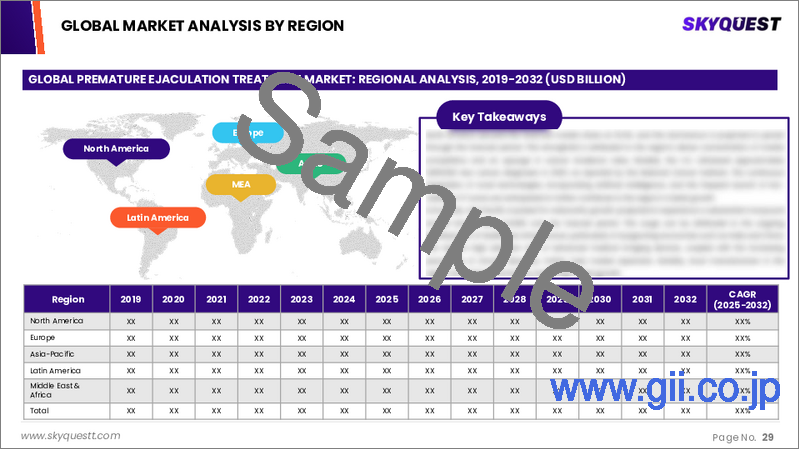|
|
市場調査レポート
商品コード
1764757
早漏治療の市場規模、シェア、成長分析、薬物タイプ別、治療タイプ別、剤形別、流通チャネル別、地域別 - 産業予測、2025年~2032年Premature Ejaculation Treatment Market Size, Share, and Growth Analysis, By Drug Type (Dapoxetine, Phosphodiesterase Type 5 Inhibitors), By Treatment Type, By Dosage Form, By Distribution Channel, By Region - Industry Forecast 2025-2032 |
||||||
|
|||||||
| 早漏治療の市場規模、シェア、成長分析、薬物タイプ別、治療タイプ別、剤形別、流通チャネル別、地域別 - 産業予測、2025年~2032年 |
|
出版日: 2025年07月04日
発行: SkyQuest
ページ情報: 英文 191 Pages
納期: 3~5営業日
|
全表示
- 概要
- 目次
早漏治療の世界市場規模は2023年に27億米ドルと評価され、2024年の29億1,000万米ドルから2032年には52億2,000万米ドルに成長し、予測期間(2025年~2032年)のCAGRは7.6%で成長する見通しです。
世界の早漏(PE)治療市場は、消費者行動の変化、男性の性の健康に対する意識の高まり、デジタル治療薬の進歩に後押しされ、大きく成長する見通しです。世界各国の政府は、より広範な公衆衛生戦略の一環として、デジタルヘルス・インフラへの注力を強化し、遠隔医療ソリューションへのアクセスを拡大しています。特に、バイエルAGとテレクリニックのような企業間の提携は、治療モジュール、電子処方箋、リアルタイムの患者フィードバックを提供するデジタルPE治療プラットフォームを構築しています。このイニシアチブは、男性のセクシュアルヘルスにまつわる偏見に対処しながら、アクセスしやすく質の高いケアを確保するドイツの取り組みと一致しています。リアルタイム適応型CBT、AI、機械学習を含むバイオテクノロジー、デジタルヘルス、遠隔医療の革新は、2024年に開始される5GとIoT対応遠隔監視装置によってさらにサポートされ、治療効果を高めます。
目次
イントロダクション
- 調査の目的
- 調査範囲
- 定義
調査手法
- 情報調達
- 二次と一次データの方法
- 市場規模予測
- 市場の前提条件と制限
エグゼクティブサマリー
- 世界市場の見通し
- 供給と需要の動向分析
- セグメント別機会分析
市場力学と見通し
- 市場概要
- 市場規模
- 市場力学
- 促進要因と機会
- 抑制要因と課題
- ポーターの分析
主な市場の考察
- 重要成功要因
- 競合の程度
- 主な投資機会
- 市場エコシステム
- 市場の魅力指数(2024年)
- PESTEL分析
- マクロ経済指標
- バリューチェーン分析
- 価格分析
- ケーススタディ
早漏治療市場規模:薬剤タイプ別& CAGR(2025年~2032年)
- 市場概要
- ダポキセチン
- ホスホジエステラーゼ5型(PDE5)阻害剤
- 選択的セロトニン再取り込み阻害薬
- 局所麻酔薬
- ゼルタネ
早漏治療市場規模:治療タイプ別& CAGR(2025年~2032年)
- 市場概要
- 経口療法
- 局所療法
早漏治療市場規模:剤形別& CAGR(2025年~2032年)
- 市場概要
- 錠剤
- スプレー
早漏治療市場規模:流通チャネル別& CAGR(2025年~2032年)
- 市場概要
- 病院
- オンライン薬局
- 小売薬局
早漏治療市場規模:地域別& CAGR(2025年~2032年)
- 北米
- 米国
- カナダ
- 欧州
- ドイツ
- スペイン
- フランス
- 英国
- イタリア
- その他欧州地域
- アジア太平洋地域
- 中国
- インド
- 日本
- 韓国
- その他アジア太平洋地域
- ラテンアメリカ
- ブラジル
- その他ラテンアメリカ地域
- 中東・アフリカ
- GCC諸国
- 南アフリカ
- その他中東・アフリカ
競合情報
- 上位5社の比較
- 主要企業の市場ポジショニング(2024年)
- 主な市場企業が採用した戦略
- 最近の市場動向
- 企業の市場シェア分析(2024年)
- 主要企業の企業プロファイル
- 企業の詳細
- 製品ポートフォリオ分析
- 企業のセグメント別シェア分析
- 収益の前年比比較(2022-2024年)
主要企業プロファイル
- Menarini Industrie Farmaceutiche Riunite Srl
- Absorption Pharmaceuticals LLC
- Alembic Pharmaceuticals Ltd.
- Amneal Pharmaceuticals Inc.
- Aytu BioPharma Inc.
- Bayer AG
- Eli Lilly and Co.
- Futura Medical Plc
- GlaxoSmithKline Plc
- Johnson and Johnson Inc.
- LloydsPharmacy
- NeuroHealing Pharmaceuticals Inc.
- Niksan Pharmaceutical
- Pfizer Inc.
- Plethora Solutions Ltd.
- Prinston Pharmaceutical Inc.
- Sunrise Remedies Pvt. Ltd.
- Tabuk Pharmaceuticals
- Veru Inc.
結論と提言
Global Premature Ejaculation Treatment Market size was valued at USD 2.7 billion in 2023 and is poised to grow from USD 2.91 billion in 2024 to USD 5.22 billion by 2032, growing at a CAGR of 7.6% during the forecast period (2025-2032).
The global premature ejaculation (PE) treatment market is poised for significant growth, fueled by shifting consumer behaviors, heightened awareness of male sexual health, and advancements in digital therapeutics. Governments worldwide are intensifying their focus on digital health infrastructure and expanding access to telemedicine solutions as part of broader public health strategies. Notably, partnerships between companies like Bayer AG and TeleClinic are creating digital PE treatment platforms that offer therapy modules, e-prescriptions, and real-time patient feedback. This initiative aligns with Germany's efforts to ensure accessible, high-quality care while addressing stigma around male sexual health. Innovations in biotechnology, digital health, and telemedicine, including real-time adaptive CBT, AI, and machine learning, enhance treatment efficacy, supported further by 5G and IoT-enabled remote monitoring devices set to launch in 2024.
Top-down and bottom-up approaches were used to estimate and validate the size of the Global Premature Ejaculation Treatment market and to estimate the size of various other dependent submarkets. The research methodology used to estimate the market size includes the following details: The key players in the market were identified through secondary research, and their market shares in the respective regions were determined through primary and secondary research. This entire procedure includes the study of the annual and financial reports of the top market players and extensive interviews for key insights from industry leaders such as CEOs, VPs, directors, and marketing executives. All percentage shares split, and breakdowns were determined using secondary sources and verified through Primary sources. All possible parameters that affect the markets covered in this research study have been accounted for, viewed in extensive detail, verified through primary research, and analyzed to get the final quantitative and qualitative data.
Global Premature Ejaculation Treatment Market Segments Analysis
Global Premature Ejaculation Treatment Market is segmented by Drug Type, Treatment Type, Dosage Form, Distribution Channel and region. Based on Drug Type, the market is segmented into Dapoxetine, Phosphodiesterase Type 5 (PDE5) Inhibitors, Selective Serotonin Reuptake Inhibitors, Topical Anesthetics and Zertane. Based on Treatment Type, the market is segmented into Oral Therapies and Topical Therapies. Based on Dosage Form, the market is segmented into Pills and Spray. Based on Distribution Channel, the market is segmented into Hospitals, Online Pharmacies and Retail Pharmacies. Based on region, the market is segmented into North America, Europe, Asia Pacific, Latin America and Middle East & Africa.
Driver of the Global Premature Ejaculation Treatment Market
A significant trend propelling the global premature ejaculation treatment market is the gradual breakdown of the stigma associated with male sexual health. Historically, premature ejaculation (PE) was often underreported due to societal taboos and feelings of embarrassment. However, increased awareness initiatives, digital health education, and endorsements from celebrities on global platforms have fostered open discussions about the condition. This shift has encouraged more men to seek treatment and address their concerns, leading to heightened visibility of PE and contributing to the growth of the market. As a result, the landscape for male sexual wellness is evolving positively.
Restraints in the Global Premature Ejaculation Treatment Market
The Global Premature Ejaculation Treatment market faces significant challenges primarily due to price barriers and insufficient reimbursement policies. For example, branded treatments like Dapoxetine can be prohibitively expensive, costing up to ten times more than local herbal alternatives or generic antidepressants. While generic options exist, their reliability and regulation are often questionable, which raises concerns about quality and hinders market growth. Additionally, the lack of public funding for sexual health awareness initiatives and care subsidies exacerbates the situation. This not only shrinks the potential market size but also discourages foreign companies from entering or expanding in regions with limited financial means.
Market Trends of the Global Premature Ejaculation Treatment Market
The Global Premature Ejaculation Treatment market is witnessing a significant shift driven by the rise of telehealth platforms enhanced by artificial intelligence. Tools like TeleClinic, ZAVA, and Roman Health leverage AI to offer smart consultations, progress tracking, and e-prescription capabilities, catering largely to young and semi-urban males. This digital transformation improves treatment adherence and monitoring, paving the way for more accurate diagnoses and personalized follow-up care. As these innovative solutions gain traction, they are poised to increase market penetration for tech-driven premature ejaculation treatment, ultimately reshaping patient experiences and outcomes in sexual health management.
Table of Contents
Introduction
- Objectives of the Study
- Scope of the Report
- Definitions
Research Methodology
- Information Procurement
- Secondary & Primary Data Methods
- Market Size Estimation
- Market Assumptions & Limitations
Executive Summary
- Global Market Outlook
- Supply & Demand Trend Analysis
- Segmental Opportunity Analysis
Market Dynamics & Outlook
- Market Overview
- Market Size
- Market Dynamics
- Drivers & Opportunities
- Restraints & Challenges
- Porters Analysis
- Competitive rivalry
- Threat of substitute
- Bargaining power of buyers
- Threat of new entrants
- Bargaining power of suppliers
Key Market Insights
- Key Success Factors
- Degree of Competition
- Top Investment Pockets
- Market Ecosystem
- Market Attractiveness Index, 2024
- PESTEL Analysis
- Macro-Economic Indicators
- Value Chain Analysis
- Pricing Analysis
- Case Studies
Global Premature Ejaculation Treatment Market Size by Drug Type & CAGR (2025-2032)
- Market Overview
- Dapoxetine
- Phosphodiesterase Type 5 (PDE5) Inhibitors
- Selective Serotonin Reuptake Inhibitors
- Topical Anesthetics
- Zertane
Global Premature Ejaculation Treatment Market Size by Treatment Type & CAGR (2025-2032)
- Market Overview
- Oral Therapies
- Topical Therapies
Global Premature Ejaculation Treatment Market Size by Dosage Form & CAGR (2025-2032)
- Market Overview
- Pills
- Spray
Global Premature Ejaculation Treatment Market Size by Distribution Channel & CAGR (2025-2032)
- Market Overview
- Hospitals
- Online Pharmacies
- Retail Pharmacies
Global Premature Ejaculation Treatment Market Size & CAGR (2025-2032)
- North America (Drug Type, Treatment Type, Dosage Form, Distribution Channel)
- US
- Canada
- Europe (Drug Type, Treatment Type, Dosage Form, Distribution Channel)
- Germany
- Spain
- France
- UK
- Italy
- Rest of Europe
- Asia Pacific (Drug Type, Treatment Type, Dosage Form, Distribution Channel)
- China
- India
- Japan
- South Korea
- Rest of Asia-Pacific
- Latin America (Drug Type, Treatment Type, Dosage Form, Distribution Channel)
- Brazil
- Rest of Latin America
- Middle East & Africa (Drug Type, Treatment Type, Dosage Form, Distribution Channel)
- GCC Countries
- South Africa
- Rest of Middle East & Africa
Competitive Intelligence
- Top 5 Player Comparison
- Market Positioning of Key Players, 2024
- Strategies Adopted by Key Market Players
- Recent Developments in the Market
- Company Market Share Analysis, 2024
- Company Profiles of All Key Players
- Company Details
- Product Portfolio Analysis
- Company's Segmental Share Analysis
- Revenue Y-O-Y Comparison (2022-2024)
Key Company Profiles
- Menarini Industrie Farmaceutiche Riunite Srl
- Company Overview
- Business Segment Overview
- Financial Updates
- Key Developments
- Absorption Pharmaceuticals LLC
- Company Overview
- Business Segment Overview
- Financial Updates
- Key Developments
- Alembic Pharmaceuticals Ltd.
- Company Overview
- Business Segment Overview
- Financial Updates
- Key Developments
- Amneal Pharmaceuticals Inc.
- Company Overview
- Business Segment Overview
- Financial Updates
- Key Developments
- Aytu BioPharma Inc.
- Company Overview
- Business Segment Overview
- Financial Updates
- Key Developments
- Bayer AG
- Company Overview
- Business Segment Overview
- Financial Updates
- Key Developments
- Eli Lilly and Co.
- Company Overview
- Business Segment Overview
- Financial Updates
- Key Developments
- Futura Medical Plc
- Company Overview
- Business Segment Overview
- Financial Updates
- Key Developments
- GlaxoSmithKline Plc
- Company Overview
- Business Segment Overview
- Financial Updates
- Key Developments
- Johnson and Johnson Inc.
- Company Overview
- Business Segment Overview
- Financial Updates
- Key Developments
- LloydsPharmacy
- Company Overview
- Business Segment Overview
- Financial Updates
- Key Developments
- NeuroHealing Pharmaceuticals Inc.
- Company Overview
- Business Segment Overview
- Financial Updates
- Key Developments
- Niksan Pharmaceutical
- Company Overview
- Business Segment Overview
- Financial Updates
- Key Developments
- Pfizer Inc.
- Company Overview
- Business Segment Overview
- Financial Updates
- Key Developments
- Plethora Solutions Ltd.
- Company Overview
- Business Segment Overview
- Financial Updates
- Key Developments
- Prinston Pharmaceutical Inc.
- Company Overview
- Business Segment Overview
- Financial Updates
- Key Developments
- Sunrise Remedies Pvt. Ltd.
- Company Overview
- Business Segment Overview
- Financial Updates
- Key Developments
- Tabuk Pharmaceuticals
- Company Overview
- Business Segment Overview
- Financial Updates
- Key Developments
- Veru Inc.
- Company Overview
- Business Segment Overview
- Financial Updates
- Key Developments






